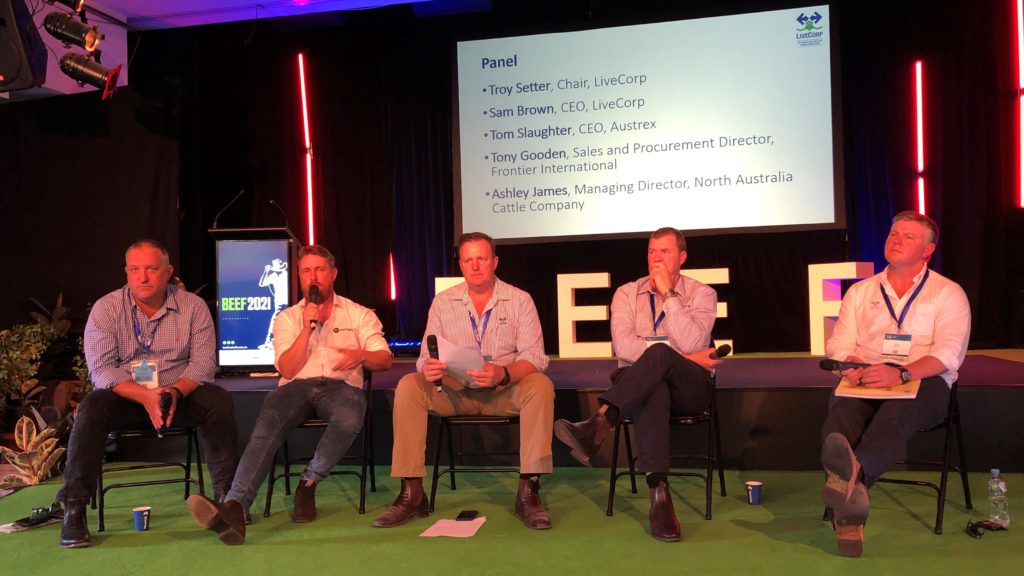Balancing expectations and reality
Leading exporters provided first-hand insights into the industry’s daily balancing act between commercial pressures and community expectations, during LiveCorp’s seminar at Beef Australia in May 2021 (panel members are listed below).
There is no ‘typical’ voyage in such a diverse industry, but the logistics involved are the same. The biggest cost to exporters is the livestock themselves, at around 70%, and Tony Gooden from Frontier noted a consignment to South East Asia may require around $5 million of capital up front.
He explained the importance of having cattle delivered as requested, with ships costing around $50,000 a day whether they are sailing or not. Most exporters charter ships rather than owning them, and they may have to sail with fewer livestock than planned if a truckload did not arrive in time for the animals to spend the regulated number of days in the pre-export quarantine feedlot before being loaded.
Ashley James from NACC added that it’s also important that the cattle meet the specifications outlined in the sale, given the strict regulations on the amount of space required for each type of animal on the ships. For instance, cattle with horns longer than 12cm need twice the room of ones the same size without horns, so there’s a dramatic effect on the number in a shipment if horned cattle are delivered without warning.
Tom Slaughter from AUSTREX said specifications are especially important for breeders. The company does a lot of work with China, which is very focused on food security and buying dairy cattle to help build up its herd.
It is a labour intensive process, with an experienced team of buyers across Australia visiting farms from up to 12 months before a shipment to select individual animals, making sure they are pure bred and meet all the criteria.
Cattle for one shipment to China may come from 600 farms, which makes for a lot of paperwork. For every one of the animals, the company needs tag numbers, property of origin certificates, national vendor declarations and various health certificates.
AUSTREX has staff who remain in market once the cattle arrive, sometimes up to 18 months, to check on their performance, provide support and build relationships with customers. Across all its operations, the company has 17 staff in various countries whose job it is to check on the livestock and the facilities in the supply chain.
For NACC, 60% of staff are dedicated to animal welfare and compliance. The company also works with a third party which provides 24/7 video monitoring of cattle in Vietnam, checking on the way animals are handled and slaughtered.
Abattoirs in Vietnam range from large operations similar to those in Australia through to smaller facilities which slaughter just four or five head of cattle a week. Regardless of the size and sophistication, Australian exporters have the same responsibilities to ensure every facility is doing the right thing.
When asked about evidence of past mistreatment of cattle in market, all exporters agreed that it’s not the norm – but should not happen to even one animal out of the hundreds of thousands exported.
Tony said customer selection is critical. Frontier has invested heavily in working with importers and others in the supply chain, and those operators understand they get better outcomes if the cattle are slaughtered in a Western-style system.
Ashley was firm that there are no second chances for supply chain partners who do the wrong thing – they are immediately suspended from receiving cattle, never to be supplied again.
The conversation turned to technology, and Sam Brown from LiveCorp outlined what the R&D corporation is doing for the industry. Problems with connectivity within ships is the focus of the latest project, as an automated way of transferring data from the decks to a central point is essential before industry can make the most of the increasing availability of environmental and livestock monitoring solutions.
Ashley agreed on the importance of this, talking about a hat with a built in camera he had seen at a recent lotfeeding seminar that he is keen to test in a live export environment. It has the potential to allow shipboard stock hands to show a shore-based veterinarian an animal in real time and get advice – but requires both connectivity within the ship, and ship-to-shore.
Overall, it was a positive discussion, and provided a valuable opportunity for the industry to engage with beef producers and others in the supply chain.

Panel members: Troy Setter, Chair, LiveCorp and Chief Executive Officer, Consolidated Pastoral Company; Sam Brown, Chief Executive Officer, LiveCorp; Tom Slaughter, Chief Executive Officer, AUSTREX; Tony Gooden, Sales and Procurement Director, Frontier international, and; Ashley James, Managing Director, North Australia Cattle Company.
This article was originally published on the LiveCorp website.
